OnePlus One - first among the best
For about 3 months, the Chinese company OnePlus, whose roots grow from Oppo, on April 23 in Beijing announced the Android Communicator One, which relied on a combination of first-class equipment, high-quality software and more than affordable prices. Probably, almost everyone who is interested in new products in the mobile industry knows about the new device. Mad rush, a huge number of thoughts and impressions immediately appeared on the web after the release of the gadget. Many were even ready to break your smartphone for a cool new product!
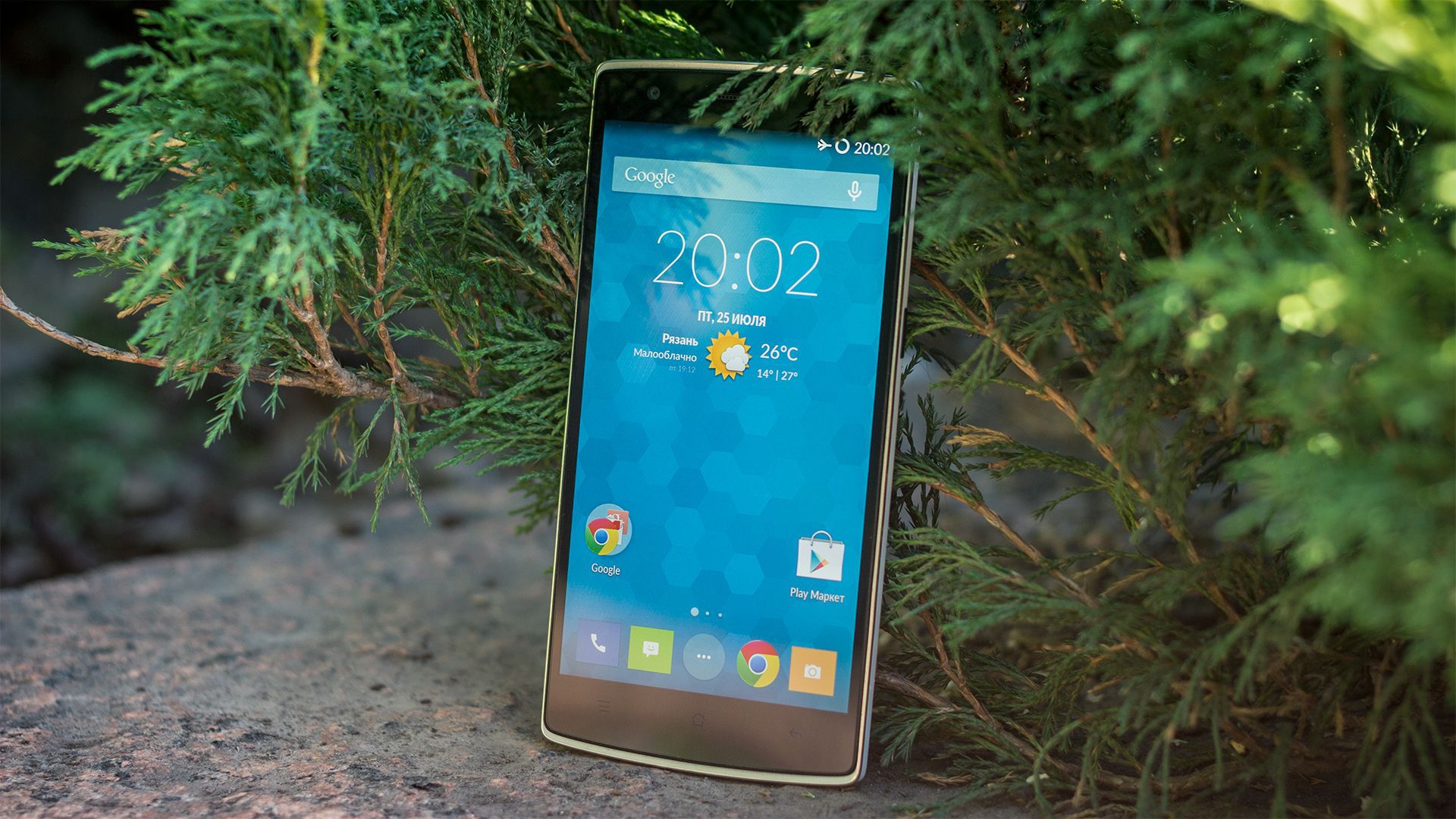
But why is OnePlus One so interesting? Why is it called the flagship killer? And where is this miracle to get? Let's see together!
OnePlus One is equipped with a Qualcomm Snapdragon 801 (8974AC) quad-core processor with a clock frequency of 2.5 GHz, 3 GB of RAM and a quality 5.5-inch Full HD display made by JDI, protected by Gorilla Glass 3 glass. modified shell CyanogenMod 11S.
')

Other OnePlus One features include NFC, Wi-Fi (2.4G / 5G) 802.11 b / g / n / ac, Bluetooth 4.0, GPS, 4G networks (LTE) support and JBL stereo speakers.
 Screen: 5.5 ", 1920 × 1080 px, FHD, LTPS IPS
Screen: 5.5 ", 1920 × 1080 px, FHD, LTPS IPS
 Processor: Qualcomm Snapdragon 801 (Krait 400, 2.5 GHz, 4 cores)
Processor: Qualcomm Snapdragon 801 (Krait 400, 2.5 GHz, 4 cores)
 Video accelerator : Adreno 330 578MHz
Video accelerator : Adreno 330 578MHz
 Operating system: CyanogenMod 11S based on Android 4.4
Operating system: CyanogenMod 11S based on Android 4.4
 RAM: 3 GB
RAM: 3 GB
 User Memory: 16 GB / 64 GB eMMC 5.0
User Memory: 16 GB / 64 GB eMMC 5.0
 Camera: front - 5 megapixel, rear - 13 megapixel
Camera: front - 5 megapixel, rear - 13 megapixel
 Connectivity: 1 SIM card (GSM / GPRS / EDGE + UMTS / HSPA + LTE)
Connectivity: 1 SIM card (GSM / GPRS / EDGE + UMTS / HSPA + LTE)
 Optional: GPS, A-GPS, GLONASS, Wi-Fi, Bluetooth, NFC, OTG, accelerometer, gyroscope, compass, indicator, light sensor and distance
Optional: GPS, A-GPS, GLONASS, Wi-Fi, Bluetooth, NFC, OTG, accelerometer, gyroscope, compass, indicator, light sensor and distance
 Battery: 3100 mAh
Battery: 3100 mAh
 Dimensions: 152.9 x 75.9 x 8.9 mm
Dimensions: 152.9 x 75.9 x 8.9 mm
 Weight: 162 grams
Weight: 162 grams
 Price: $ 357 - 16 GB (~ 12 500 rubles) | $ 425 - 64 GB (~ 14 900 rubles)
Price: $ 357 - 16 GB (~ 12 500 rubles) | $ 425 - 64 GB (~ 14 900 rubles)
In the company, everything is thought out to the smallest detail. And even the messenger box has its own design. The box was also packed in a gray bag, inside a layer of pimples.
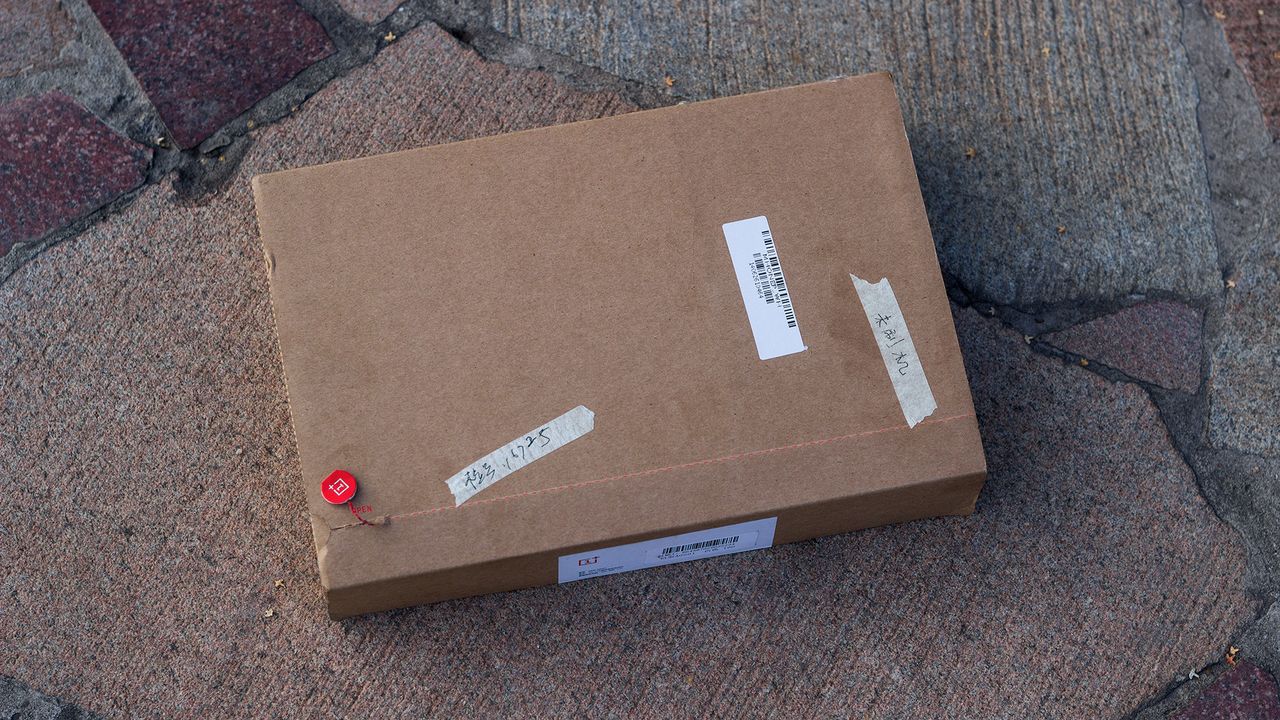
To open it you just need to pull the thread. Although I did not know about it and just cut with a knife a scotch that covered the box.

It neatly laid out two more boxes, one with the device and accessories, and the other with a charger. To the remaining space was not empty, put another foam cap.
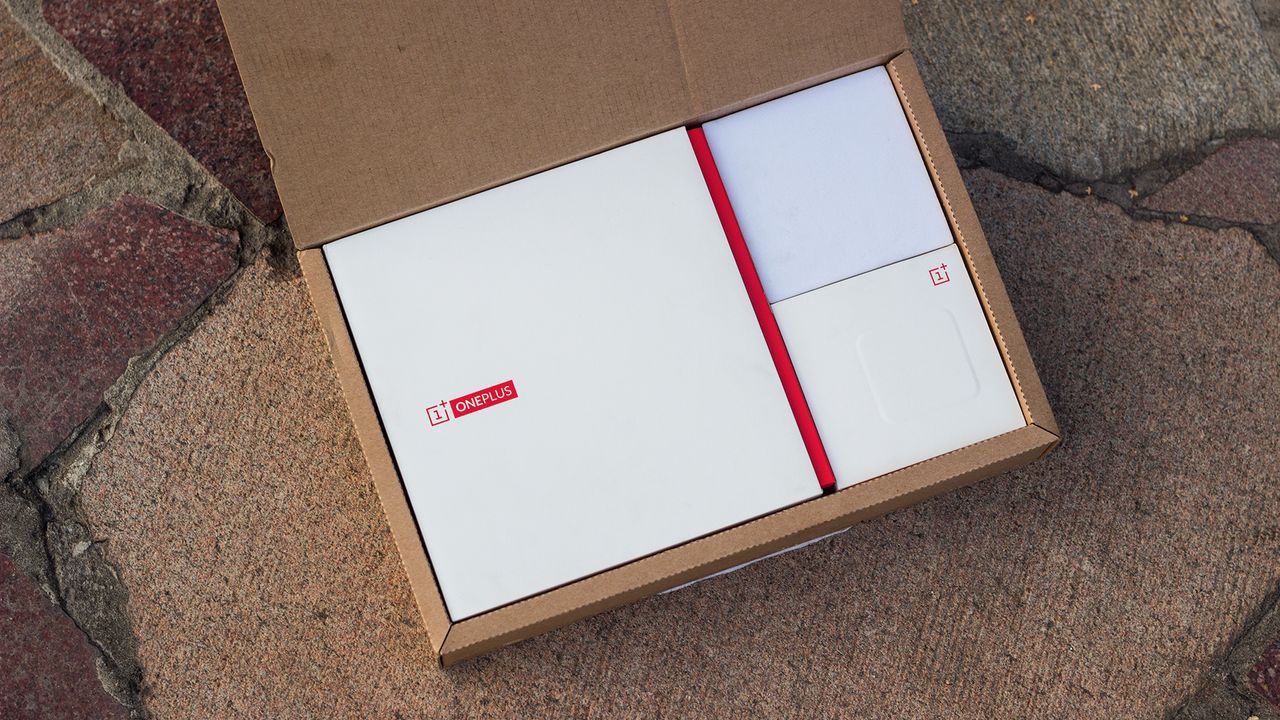
Let's start not with the most interesting thing - a box with a power supply. It also looks quite stylish in the company's corporate colors and has a silhouette of a charger.

Specifications are listed on the back.

The case of the power adapter is made of high-quality plastic, the surface is smooth to the touch.

The power supply produces 2A output, the smartphone charges in about 2 and a half hours.

And here we have the right box with something interesting inside. The smartphone comes in a chic white box, inside of which is the second box in red, one “enters” into the other.

The device itself lies in a thin red box, having a thickness of about 2 centimeters, as well as the main complete accessories.
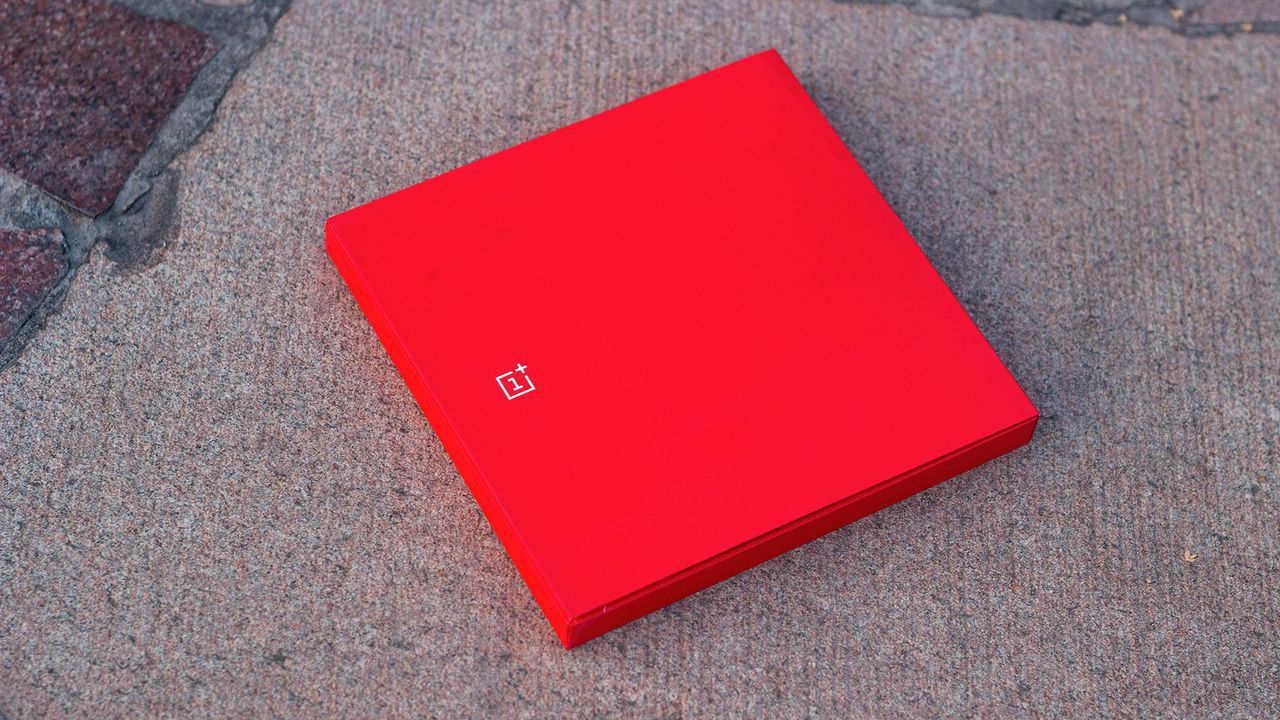
The box opens like a book. Inside at the top level the device accurately lies.
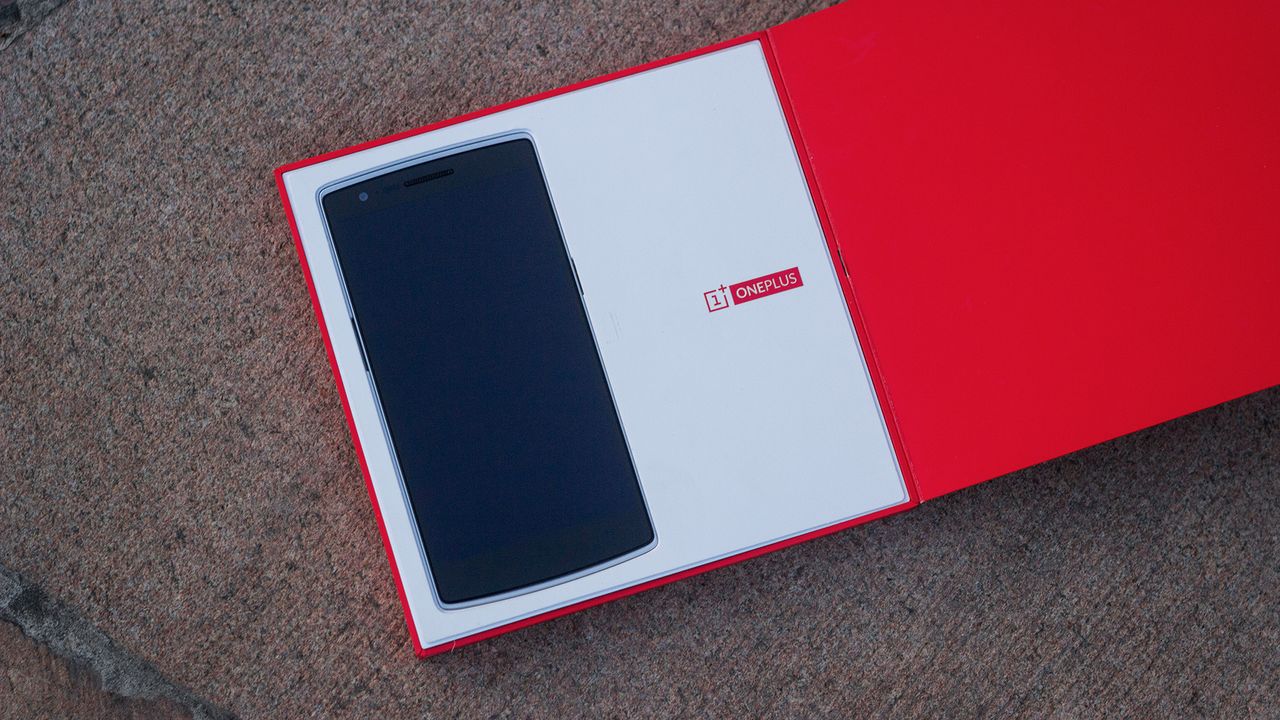
At the bottom level, accessories are very impressively laid out. There is a red microUSB cable and an iron clip for removing the SIM card tray in an individual plastic case with a metal loop for attaching to a keychain, no headphones included. There is also an instruction manual, which you can throw away, since it is completely in Chinese, and leave the envelope, it is beautiful.
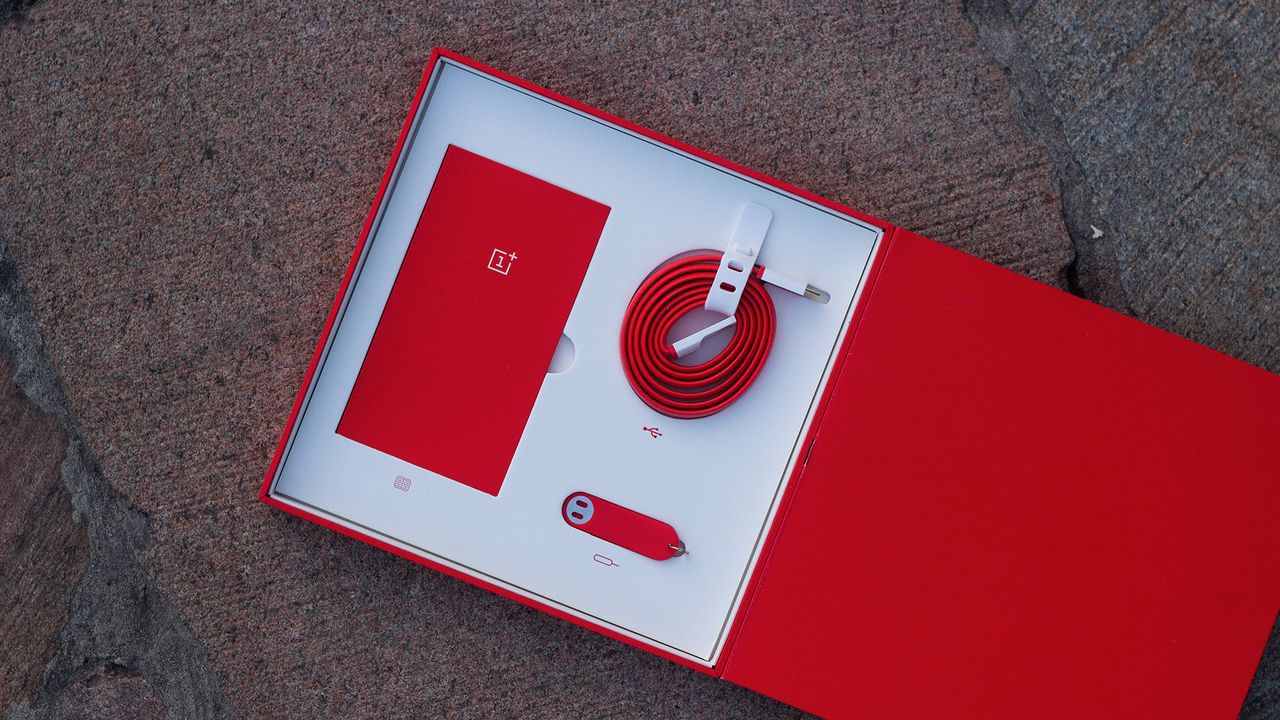
The guys from OnePlus really tried to do everything at the highest level, with particular attention paid to packaging and accessories. Each element of the box, each accessory inside literally shouts about how much quality product you hold in your hands.
The appearance of the OnePlus One is simple and concise. On the front panel you will not find a company logo, or mechanical buttons, or speakers on the edges. There is, perhaps, a small notch between the protective glass of the screen and the metal frame around it. I am glad that the company did not follow the path of copying the design, as many Chinese manufacturers do.

The front panel has a 5 megapixel front camera, motion sensor and brightness. Nearby is the indicator, which is lit in different colors. And, for example, when charging, the green color changes its shade from dull to bright when the charge level increases, it also has many more chips related to the settings for each application. In the middle is a conversational speaker, which is closed by a fine grid.
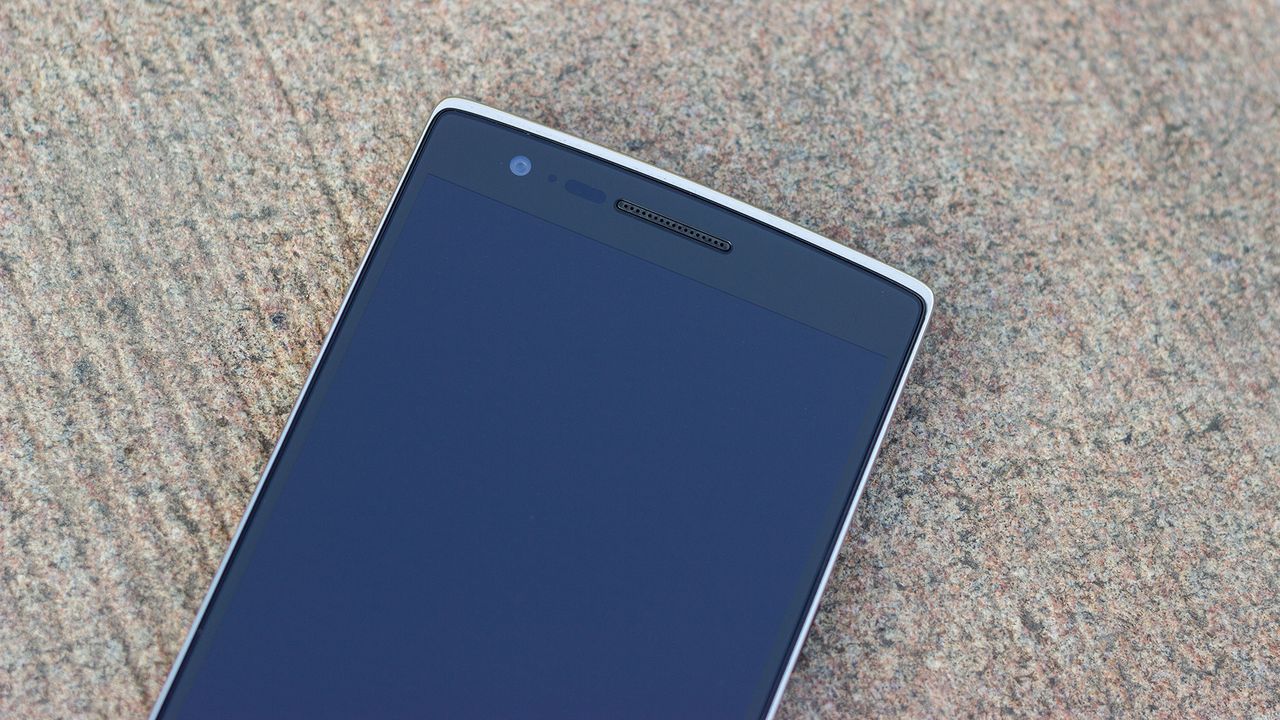
Below are slightly visible hardware buttons, which also have a backlight, but only one color - blue. The company apparently did not pay special attention to these controls, because in the settings you can choose which buttons to use - on-screen or touch-sensitive.
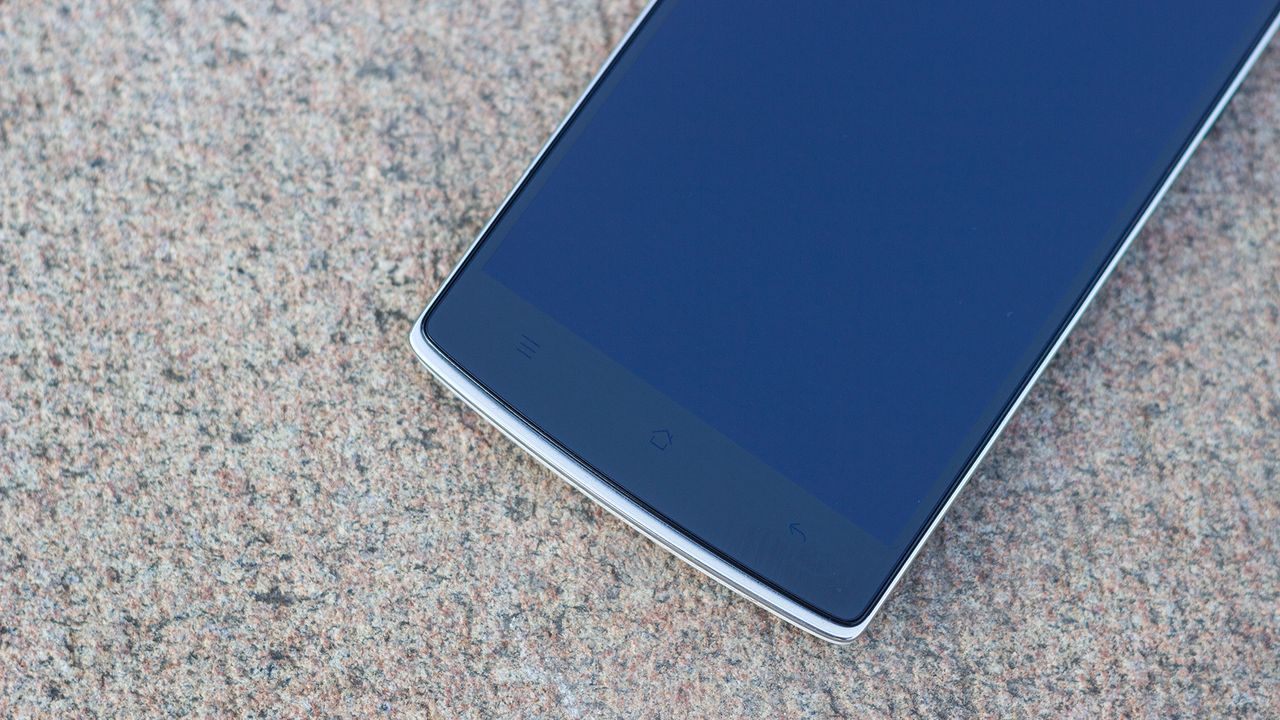
So immediately recommended to learn the functions of the buttons by heart, as in daylight they can not be seen at all. On the other hand - in the twilight and darkness, they are read perfectly comfortably.

On the left side is a volume rocker and tray for microSIM card. The tray for the SIM card is plastic; it is easily reached using the complete clip and also easily snaps back.

On the right - the power button and lock. You rarely use it because you can wake the screen by double tapping anywhere on the panel, and also make you fall back to sleep. The buttons are thin, small and tight. They are easy to grope in your pocket and quite difficult to press through carelessness.

The back cover is decorated with the engraved OnePlus company logo in black. The material of the back panel is called “silk white”, it is really very pleasant to the touch. It resembles the effect of soft-touch plastic, but without the obvious presence of rubber. If all manufacturers made their smartphones from the same pleasant plastic, the rows of aluminum fans would have thinned out significantly. On the back cover is also located 13 megapixel camera from Sony with dual LED-flash. A microphone is used to capture sound and reduce noise when recording video.
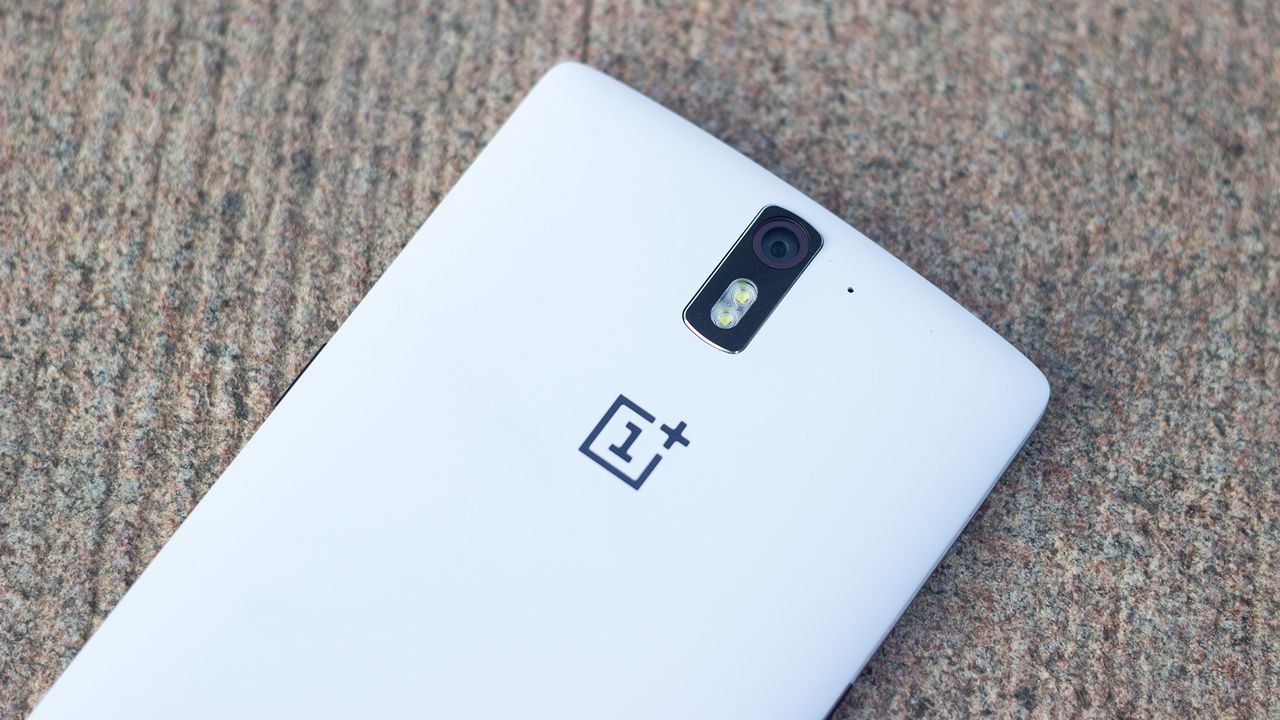
At the bottom of the entire impression spoil the Chinese inscriptions. But they can be found only if you order a smartphone from a Chinese store. If you take the device on the official website for an invite, then decorate the back cover will be a stylish inscription Cyanogen! The cover of the device is removable, but the battery itself is not. On the official website you can order different options for finishing the back cover, like Moto X - under the tree, under the fabric and others.
By the way, black OnePlus One is made of rough and velvety plastic, but otherwise the material is also practical, so choosing between colors is thoughtful, the texture of the cover will be different.
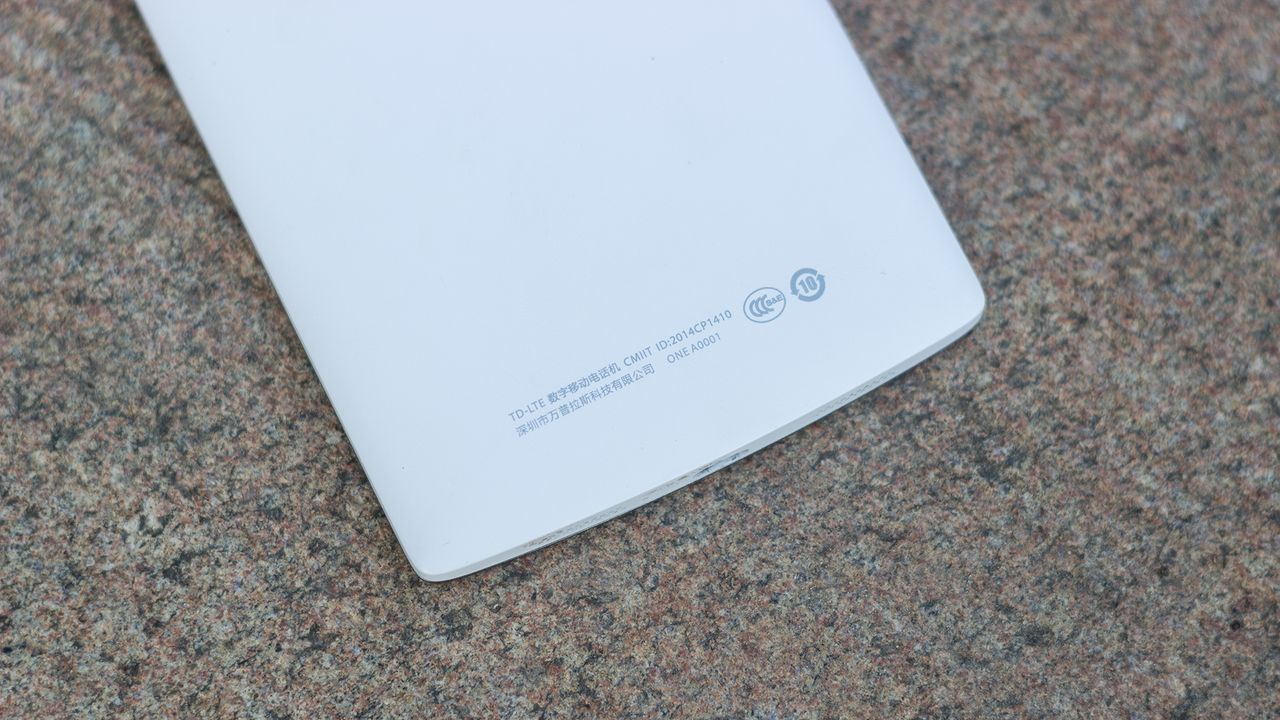
On the top there is a 3.5 mm jack for connecting a headset and an additional microphone hole. It is worth noting that OnePlus One is one of the few smartphones equipped with three microphones at once for surround sound capture from all sides. If you look at the profile, it is noticeable that the case has a curved shape, so that it is more convenient in the hand.

And at the bottom, the user will see stereo music speakers developed by JBL, a microUSB interface and a speaking microphone. The sound quality can be called high, it should be recognized that the volume of the speakers is very good and its owner can easily hear the bell even on a busy square.

Like it or not, today a smartphone with a 5.5-inch screen is quite a normal trend. OnePlus One is one of the largest smartphones on the market. When you take it in hand, it feels pretty huge, especially considering the frame around the entire perimeter of the device. If you have never used smartphones with large displays before, then I advise you to hold similar models in your hands before buying them - Samsung Galaxy Note 3 or LG G3. Nevertheless, the device fits perfectly in the palm of your hand, though it is more convenient to use and type with two hands. By the very same build quality claims do not arise, everything is done at a high level, nothing creaks or backlash, there are no gaps between the elements.
The screen of the smartphone has a diagonal of 5.5 inches and a resolution of FullHD, the pixel density is 401 PPI. It uses a high-quality LTPS IPS matrix, providing a wide color gamut and close to maximum viewing angles. Of course, the display is protected by Corning Gorilla Glass 3.
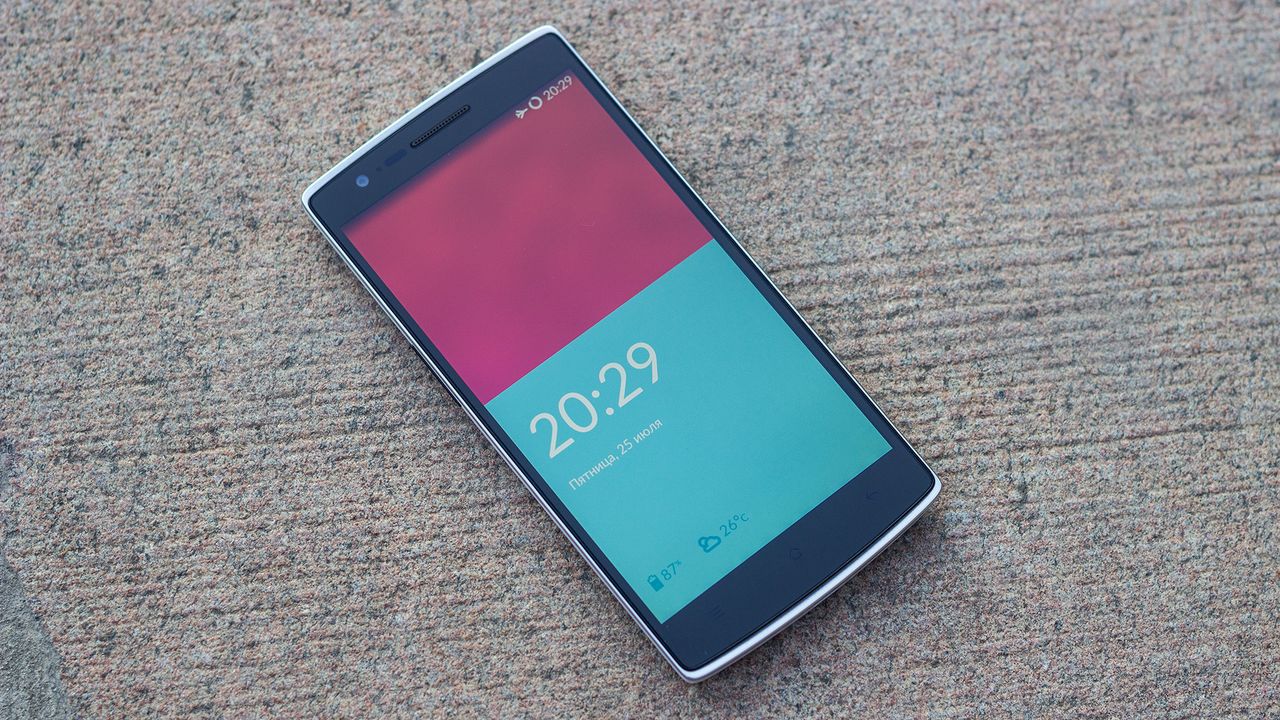
The display is made taking into account the approach TOL (touch on lens, “sensor on glass”), which reduces the number of layers of the screen due to their merging: the images become closer to the user, their brightness increases, the parallax effect is eliminated.

The thickness of the side frames from the edge of the screen to the edge of the case is about 3 mm - the frames are narrow, and against the background of the considerable dimensions of the device, they seem even thinner.
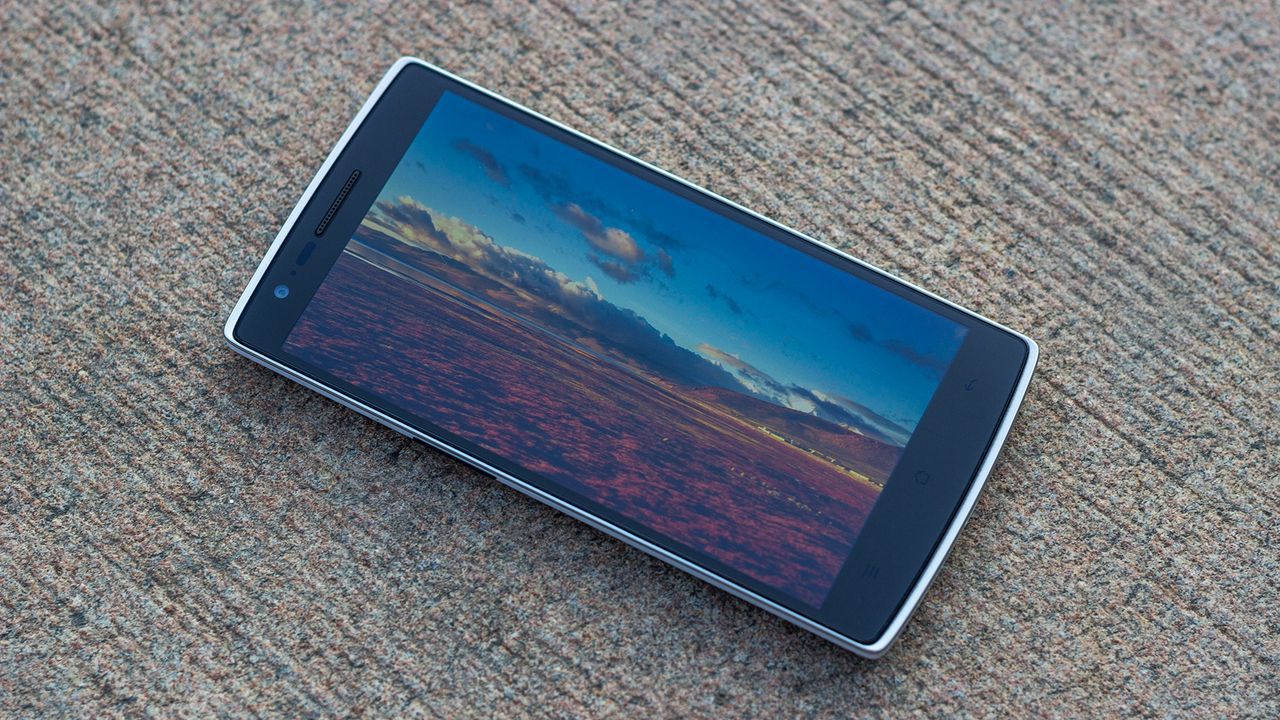
The display brightness can be adjusted manually, or you can use the automatic adjustment. Multitouch technology here allows you to handle up to 10 simultaneous touches. The touchpad responds only to fingers, gloved work is not provided.
OnePlus One is equipped with two modules of digital cameras with a resolution of 13 megapixels and 5 megapixels. The front camera takes pictures with a maximum resolution of 1944 × 2592, the video shoots in the resolution of 720p. For shooting self-portraits, the capabilities of the front camera are more than enough.

The main, rear camera has a 13 megapixel matrix with a new Sony Exmor IMX214 CMOS-sensor with reverse illumination (BSI). The camera is equipped with autofocus, two-section LED-flash, there is also a new-fashioned ability to shoot video in UHD resolution (4k). Below is a picture in Auto mode.

When shooting in the automatic mode, which is set by default, photos are obtained in the size of 4160 × 3120. Below is a picture in HDR mode.

The camera can shoot video at 1080p and DCI (4K), there is also a standard for top smartphones the ability to shoot video in slow mode (at a speed of 60 and 120 frames per second). Unfortunately, in this mode, the clips lack bitrate, which makes them look dull, with a low amount of detail.
Pleases correctly working autofocus. The camera correctly switches between a close and far-away object in less than a second. It takes the camera very quickly, it takes less than a second to create a normal image, and no more than three on the HDR.
OnePlus One is offered in two versions: with CyanogenMod firmware (version 11S) or with a proprietary ColorOS. In China, the second version is on sale, with ColorOS, with it the device arrived. The firmware certainly has its own features and interesting features, but the lack of the Russian language is distressing. Therefore, after receiving the device, I immediately reflashed it on CyanogenMod 11S, which is available on the official website cyngn.com .
"Cyanogen mod" does not need a special presentation. But for those who are not familiar with CyanogenMod, I’ll briefly say that this is the same Android (most often the latest version) with all its functionality, but beyond that, the development team provides the user with a lot of additional features. A version of 11S, created specifically for OnePlus, has a number of changes and improvements. By the way, for those who are not a fan of the CyanogenMod 11S user interface (the theme is called Hexo), you can replace it with the standard Android Holo interface.
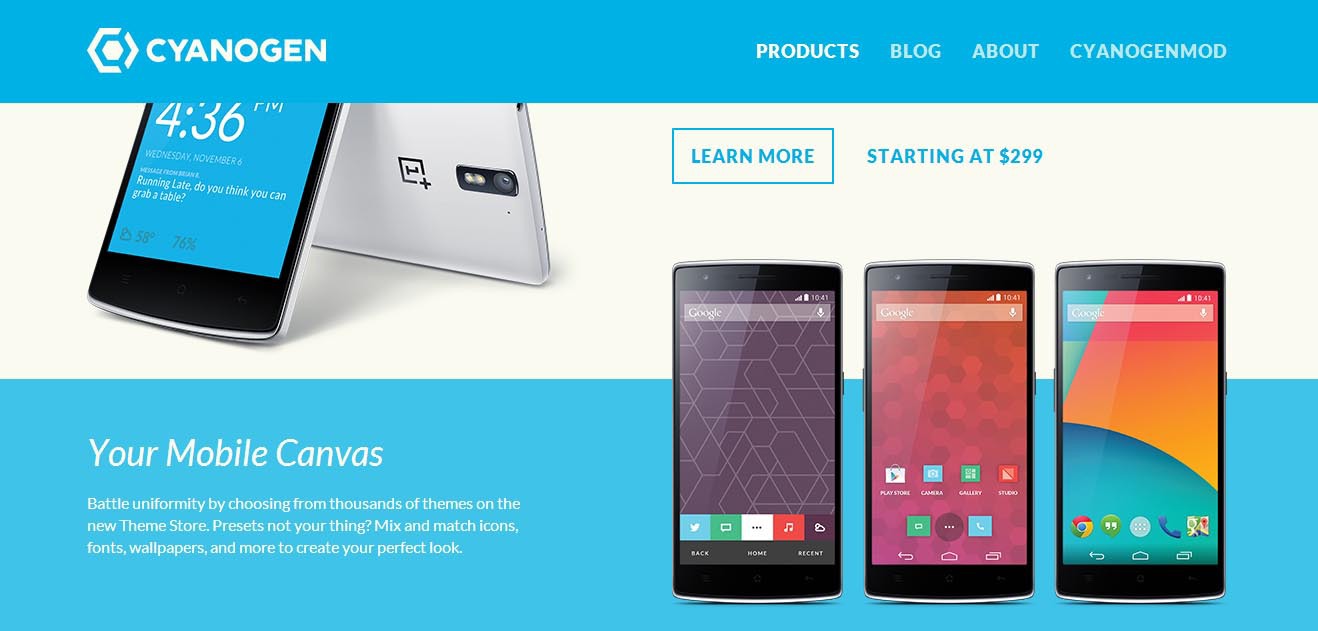
The first thing that catches your eye is the changed lock screen. Here at the bottom of the minimalistic panels shows the time, the last message received, battery charge and weather forecast. Swipe left you can still start the camera. At the top of the beautifully blurred background image of the desktop. On the lock screen, when playing music, a very nice dynamic equalizer is displayed. Most system application icons are minimalist in tile style. In terms of color scheme changes did not happen, all the same dark Android.

Going into the settings, it is immediately clear that there were more items. Indeed, CyanogenMod offers quite ample opportunities for software customization. Digging in the settings, you can significantly improve the feeling of using a smartphone.

The gallery’s own application has three photo viewing modes, including Moments, Albums and Media. In the Moments mode, pictures are sorted by date, in the Albums mode, thumbnails are stored in the photo folders. Media mode simply shows all the photos from your smartphone in a bunch. Attention is drawn to a more thoughtful display of thumbnails of the photos taken, as well as easy navigation between them.

The pre-installed software in the CM11S is minimal; the following applications can be highlighted: the default music player is Apollo, a flashlight, a functional file manager, and the cLock widget (clock / weather / calendar). The built-in utility AudioFX is an equalizer with preset settings, various profiles and reverberation control. Undoubtedly, this utility will be useful not only for audiophiles, but also for ordinary users. There is also a screencast - an application for capturing images from the screen.

The system interface can be completely changed by selecting a theme in the special Theme Store application. Some of them are available for free, but for many people they ask for money in the region of 2-3 dollars. Each theme is just a separate application on Google Play, so there should be no problems with the purchase and installation.

The camera application in OnePlus One uses a unique, written by a team of Cyanogen Mod special for this smartphone. It cannot be said that it has become much more convenient, the settings are simply designed and grouped somewhat differently, and the interface is more stylish and concise.
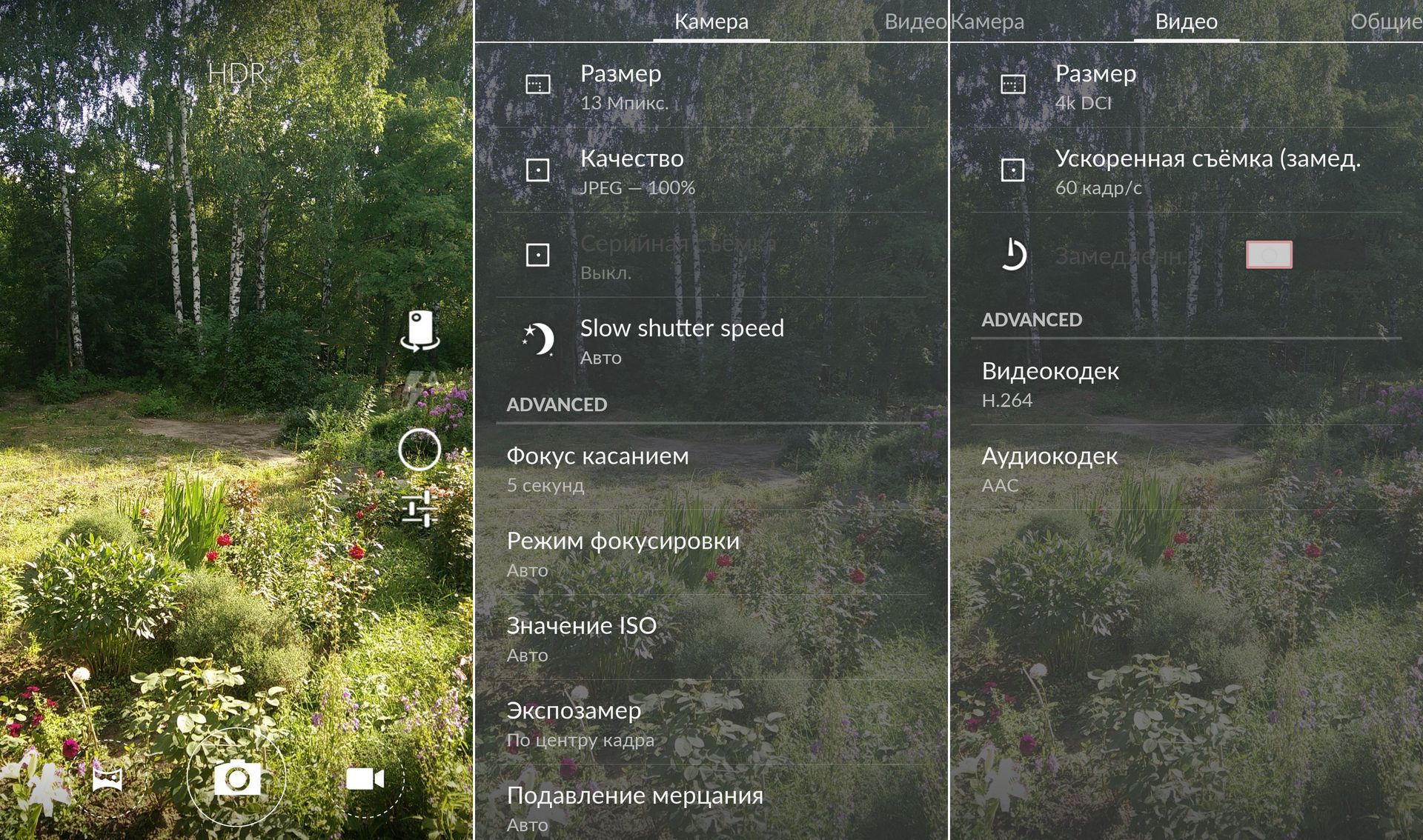
The system provides the ability to turn off the touch buttons and use the on-screen, quite a useful function, given that these buttons can be changed as you please. OnePlus One also supports gestures on a locked screen: you can activate a flashlight, camera or music player.
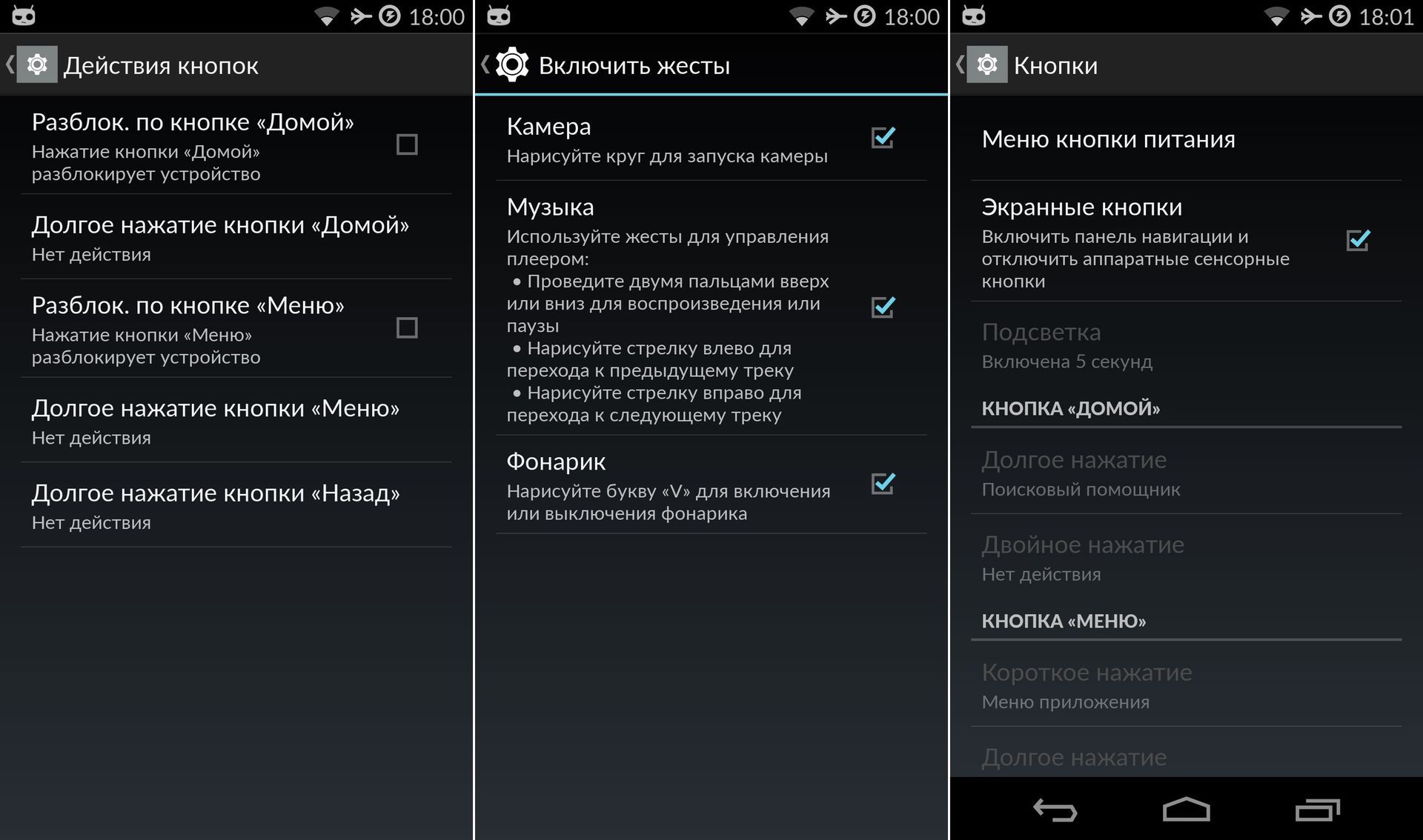
Separately, it is worth noting that it is possible to change the main parameters of the processor, including frequency limits and the choice of algorithm for controlling them. However, we must bear in mind that this is not just a list for switching profiles, and it may be difficult for an unprepared user to understand the options. That is why, by default, this add-in is hidden and enabled only by activating the developer mode.
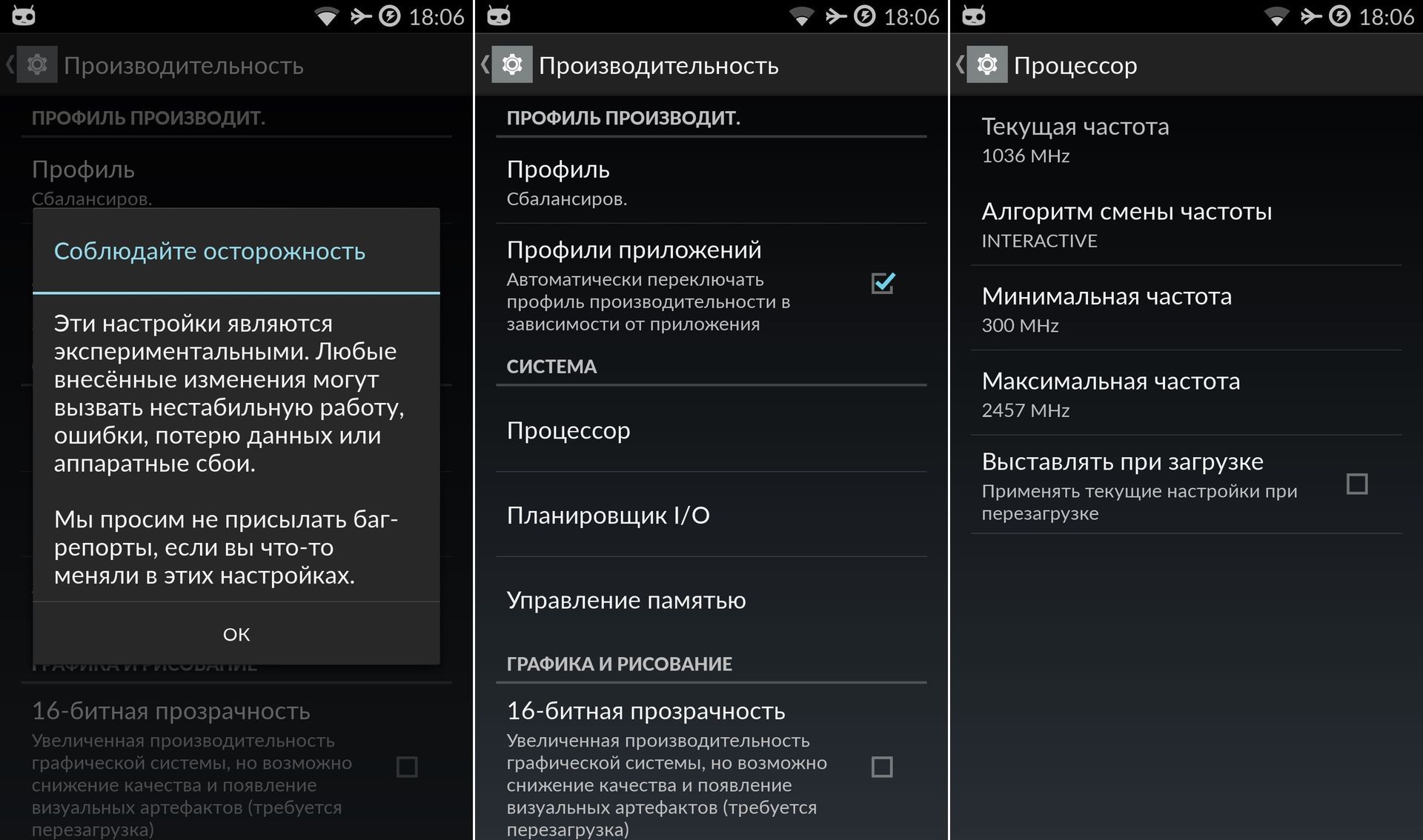
The device with CyanogenMod 11S becomes more attractive and interesting. The firmware has a huge number of built-in functions, a decent set for developers and support for a complete change of the interface, all this greatly improves the usability of the smartphone. The CM11S is stable in operation, supports all the hardware capabilities of the smartphone, and is little different from the original ColorOS version in terms of speed and battery life.
The smartphone works in GSM, HSDPA and LTE (4G) networks. The international standard 4G is supported, so that in Russia, OnePlus One works in networks of the fourth generation. And it does not matter, you have the European version (Cyanogen inscription on the back cover) or the Chinese one. For the Russian user there is no difference.

Of the additional network capabilities available, support for second-band Wi-Fi (5 GHz) and NFC technology. The external device connection mode (USB Host, OTG) is supported here, so any USB flash drives connected to the microUSB port, as well as mice with keyboards, are perfectly recognized.
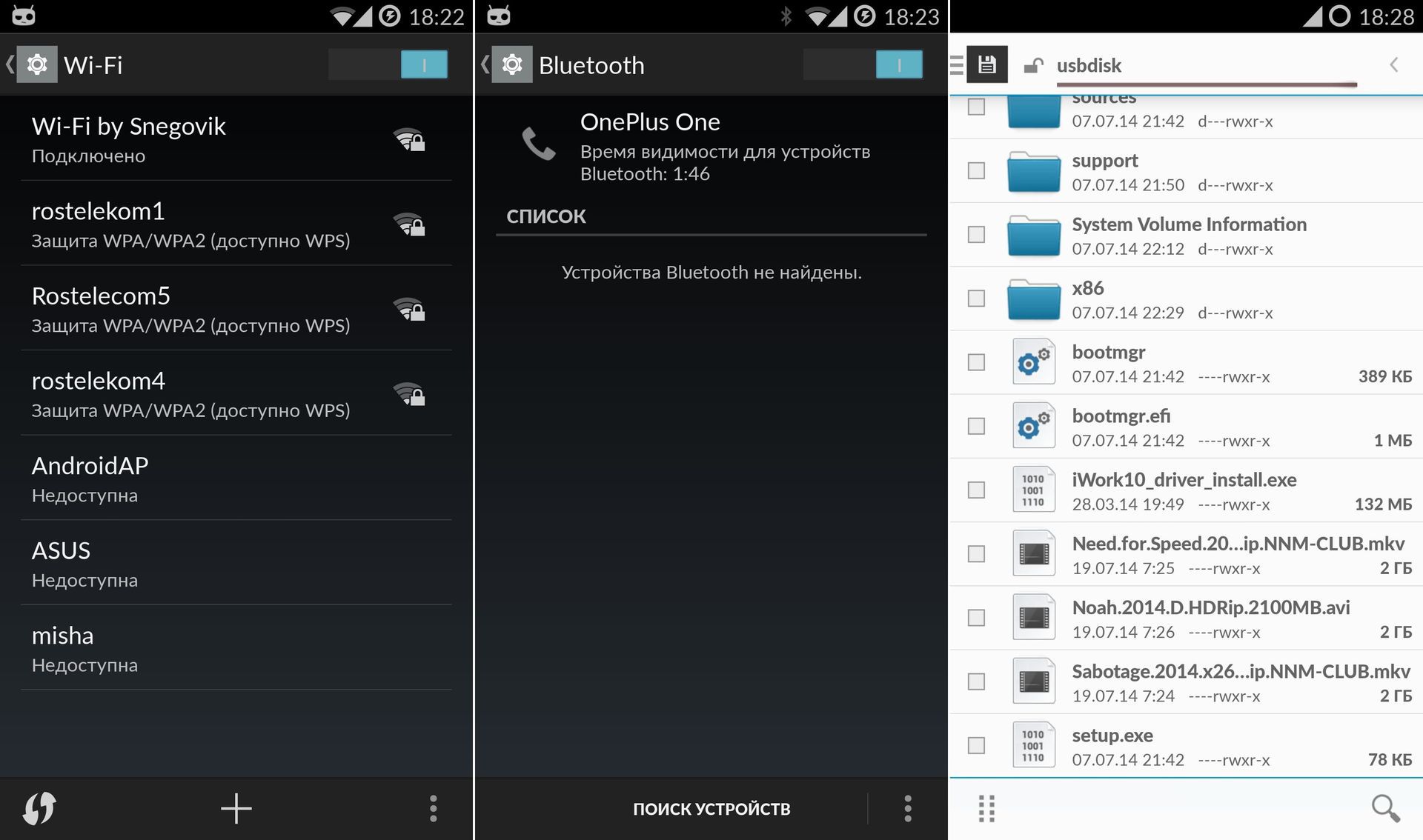
The navigation module works with both GPS and the domestic GLONASS system, and also finds satellites of the Chinese Beidou system.

All the necessary and modern modules are present, nothing to complain about. Is it only to the lack of wireless charging technology, but this is nagging.
OnePlus One is based on the Qualcomm Snapdragon 801 MSM8974AC production system. At the disposal of the buyer enters the quad-core processor, made by technology 28 nm, with an operating frequency of 2.5 GHz each core. Adreno 330 operating at 578 MHz is used as the video subsystem. All this complements the fast LP-DDR3 memory of 3 GB. What can I say, the decision at the moment is one of the top. In the benchmarks please occupy the first places occupied by the smartphone, thanks to the filling and the operating system CyanogenMod 11S.

I do not even know if it is worth saying that the OS itself, and any heavy games run on it without the slightest hint of brakes.

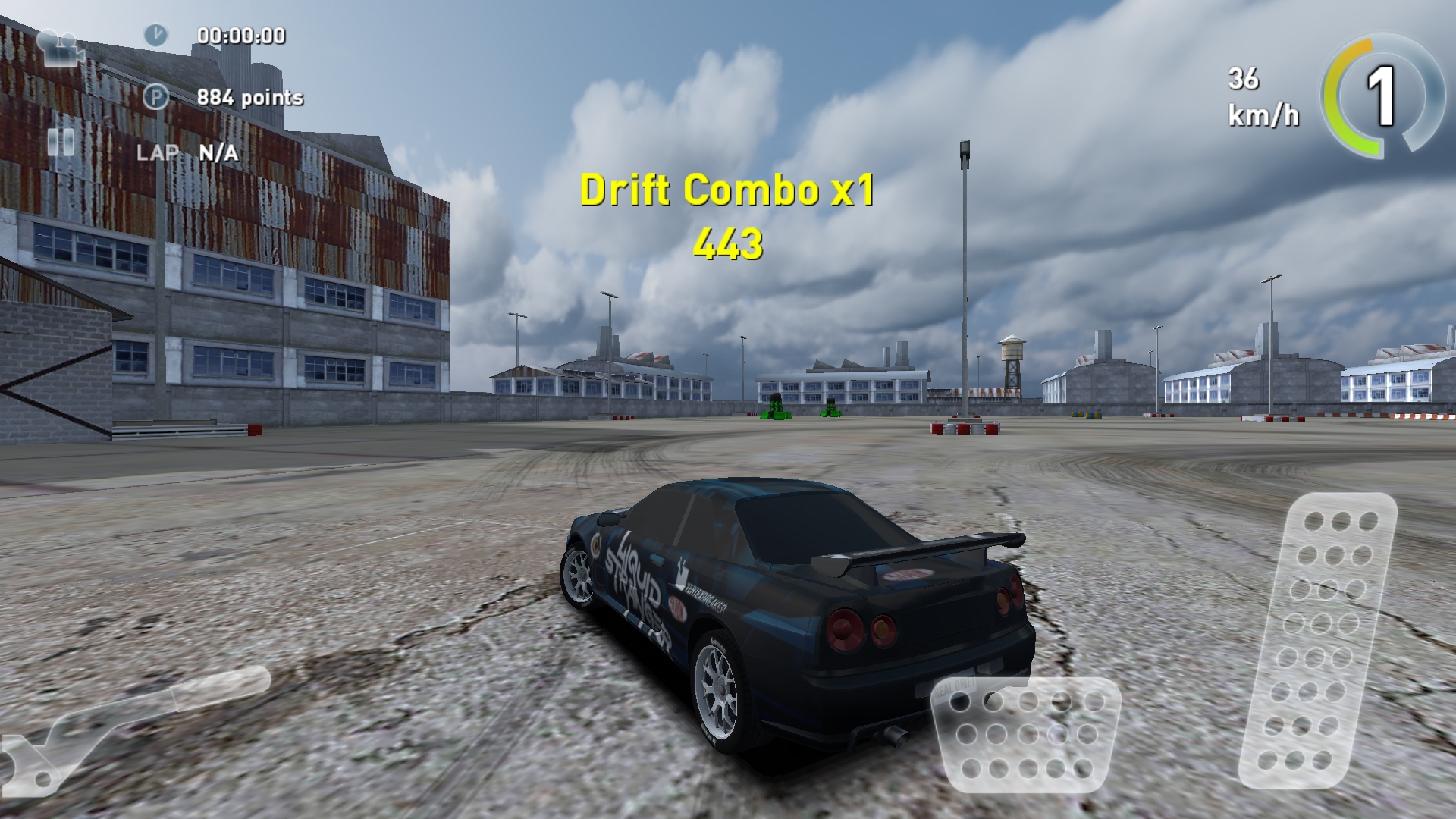

However, the smartphone in games and tests significantly heats up under heavy load and it is very unpleasant to hold it in hand (the hottest place is at the back of the camera). Hands, of course, does not burn, but I would like the device to be a little colder.
The OnePlus One has a non-removable 3100 mAh battery. Indicator is quite typical for smartphones of this size. On average, with active use, the battery lasts for the whole day.

As you can see, OnePlus One doesn’t have enough stars from the sky, but it’s worth considering that the stuffing here is very powerful and, in general, the test results can be considered satisfactory.
Let's immediately pay attention to the price. Yes, it is at a low price. And from it you need to make a start when summing up. What do we get for it? High-quality and powerful smartphone at the level of popular flagships, and even with fast firmware (which will be updated faster than others). Somewhere, OnePlus One loses to some models in terms of camera quality and the lack of a slot for a memory card with wireless charging, but otherwise everything is at the same level (and sometimes even better), especially hardware. And even if there are some flaws in this smartphone, then they can be forgiven for such a price and it must be borne in mind that One is the first product of OnePlus, and it came out successful!
If you have a small budget of up to 15,000 rubles, then you should pay attention to this smartphone. Yes, I agree that it can scare away the purchase procedure and the lack of a guarantee, but these are all trifles and are easily solved. But the dimensions are somewhat overestimated, not everyone will like this screen size, this is one of the important parameters when choosing a device. Personally, they suit me, and I hope you will get used to it!
 Nice and nice design
Nice and nice design
 High-quality display
High-quality display
 Excellent build and materials
Excellent build and materials
 Top iron and excellent performance
Top iron and excellent performance
 Loud speaker
Loud speaker
 Availability of various communications (NFC, OTG, LTE)
Availability of various communications (NFC, OTG, LTE)
 CyanogenMod 11S Firmware
CyanogenMod 11S Firmware
 4K camera
4K camera
 Long autonomous work
Long autonomous work
 Low price
Low price
 No microSD connector
No microSD connector
 Dimensions of the device
Dimensions of the device
 No wireless charging support
No wireless charging support
The official price of OnePlus One is $ 300 for the 16 GB version and $ 350 for the 64 GB version. The device is not sent to Russia, so you can only order at any address in the USA and it costs $ 15. But to buy a smartphone for this money is quite difficult, you need to get an invite (invitation to buy), and only after that you can buy a device. Invites are spreading slowly, but you can get it. Think it all? No, you still have to go through the quest with the purchase on the official website, and this is a substitution of IP, a bank card that is not tied to a Russian PayPal account, sent through an intermediary and other subtleties. If you take, for example, OnePlus One 16 GB, then together with delivery to Russia through an intermediary you will get ~ $ 349.
But there is another way - buying in a Chinese online store. For the price goes a little more expensive ($ 8), but there will be no suffering with invites, addresses in the USA, etc. It's simple - put in the basket, enter the shipping address, pay for and wait for the parcel. The delivery time is also. I have a smartphone from the online store CooliCool arrived in 15 days.
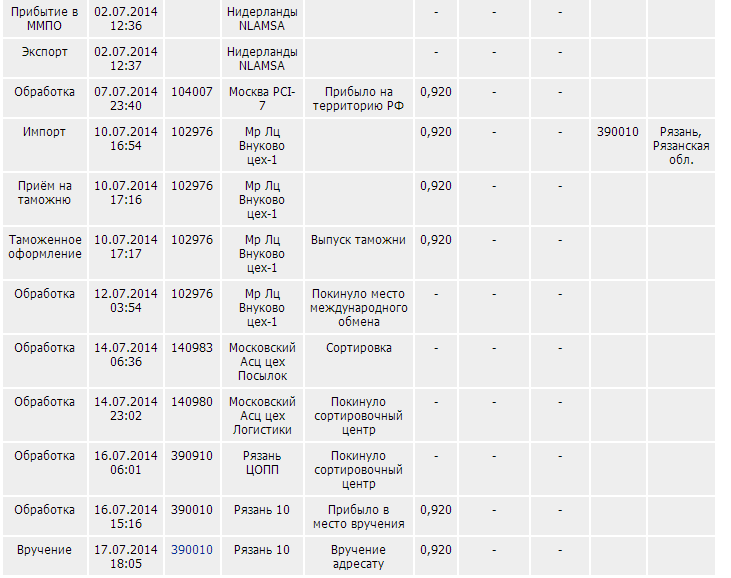
The absence of the Cyanogen inscription on the back cover - only this small nuance distinguishes the Chinese version from the one supplied to the international market. At the request of the user, he can change the ColorOS firmware firmware pre-installed in China to CyanogenMod 11S in a few minutes.
In general, buy OnePlus One 16 GB can be in the store CooliCool . Price with shipping will be $ 357 .
The OnePlus One 64 GB version can be purchased for $ 425 .
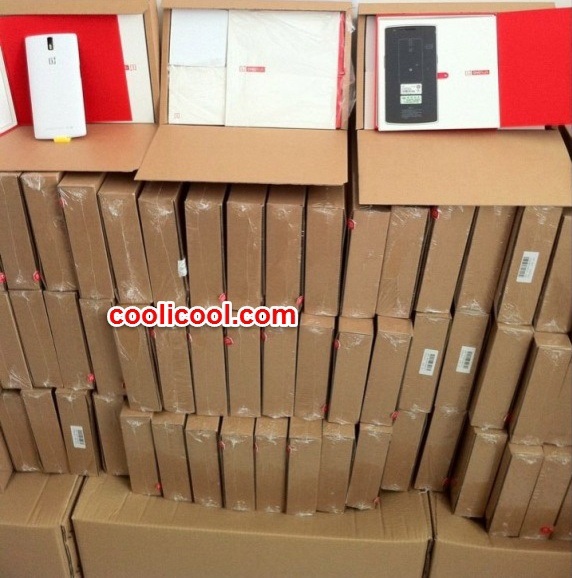
If you have any questions about the purchase, then write in a personal or in the comments, I will definitely help! Good luck with your purchases!
Do not forget to follow us on Vkontakte , Twitter and Google+ ! And of course, subscribe to our blog on Habré in the profile .

But why is OnePlus One so interesting? Why is it called the flagship killer? And where is this miracle to get? Let's see together!
▌ TECHNICAL SPECIFICATIONS
OnePlus One is equipped with a Qualcomm Snapdragon 801 (8974AC) quad-core processor with a clock frequency of 2.5 GHz, 3 GB of RAM and a quality 5.5-inch Full HD display made by JDI, protected by Gorilla Glass 3 glass. modified shell CyanogenMod 11S.
')

Other OnePlus One features include NFC, Wi-Fi (2.4G / 5G) 802.11 b / g / n / ac, Bluetooth 4.0, GPS, 4G networks (LTE) support and JBL stereo speakers.
 Screen: 5.5 ", 1920 × 1080 px, FHD, LTPS IPS
Screen: 5.5 ", 1920 × 1080 px, FHD, LTPS IPS Processor: Qualcomm Snapdragon 801 (Krait 400, 2.5 GHz, 4 cores)
Processor: Qualcomm Snapdragon 801 (Krait 400, 2.5 GHz, 4 cores) Video accelerator : Adreno 330 578MHz
Video accelerator : Adreno 330 578MHz Operating system: CyanogenMod 11S based on Android 4.4
Operating system: CyanogenMod 11S based on Android 4.4 RAM: 3 GB
RAM: 3 GB User Memory: 16 GB / 64 GB eMMC 5.0
User Memory: 16 GB / 64 GB eMMC 5.0 Camera: front - 5 megapixel, rear - 13 megapixel
Camera: front - 5 megapixel, rear - 13 megapixel Connectivity: 1 SIM card (GSM / GPRS / EDGE + UMTS / HSPA + LTE)
Connectivity: 1 SIM card (GSM / GPRS / EDGE + UMTS / HSPA + LTE) Optional: GPS, A-GPS, GLONASS, Wi-Fi, Bluetooth, NFC, OTG, accelerometer, gyroscope, compass, indicator, light sensor and distance
Optional: GPS, A-GPS, GLONASS, Wi-Fi, Bluetooth, NFC, OTG, accelerometer, gyroscope, compass, indicator, light sensor and distance Battery: 3100 mAh
Battery: 3100 mAh Dimensions: 152.9 x 75.9 x 8.9 mm
Dimensions: 152.9 x 75.9 x 8.9 mm Weight: 162 grams
Weight: 162 grams Price: $ 357 - 16 GB (~ 12 500 rubles) | $ 425 - 64 GB (~ 14 900 rubles)
Price: $ 357 - 16 GB (~ 12 500 rubles) | $ 425 - 64 GB (~ 14 900 rubles)▌ PACKING AND COMPLETE SET
In the company, everything is thought out to the smallest detail. And even the messenger box has its own design. The box was also packed in a gray bag, inside a layer of pimples.

To open it you just need to pull the thread. Although I did not know about it and just cut with a knife a scotch that covered the box.

It neatly laid out two more boxes, one with the device and accessories, and the other with a charger. To the remaining space was not empty, put another foam cap.

Let's start not with the most interesting thing - a box with a power supply. It also looks quite stylish in the company's corporate colors and has a silhouette of a charger.

Specifications are listed on the back.

The case of the power adapter is made of high-quality plastic, the surface is smooth to the touch.

The power supply produces 2A output, the smartphone charges in about 2 and a half hours.

And here we have the right box with something interesting inside. The smartphone comes in a chic white box, inside of which is the second box in red, one “enters” into the other.

The device itself lies in a thin red box, having a thickness of about 2 centimeters, as well as the main complete accessories.

The box opens like a book. Inside at the top level the device accurately lies.

At the bottom level, accessories are very impressively laid out. There is a red microUSB cable and an iron clip for removing the SIM card tray in an individual plastic case with a metal loop for attaching to a keychain, no headphones included. There is also an instruction manual, which you can throw away, since it is completely in Chinese, and leave the envelope, it is beautiful.

The guys from OnePlus really tried to do everything at the highest level, with particular attention paid to packaging and accessories. Each element of the box, each accessory inside literally shouts about how much quality product you hold in your hands.
▌ DESIGN, DIMENSIONS, CONTROL ELEMENTS
The appearance of the OnePlus One is simple and concise. On the front panel you will not find a company logo, or mechanical buttons, or speakers on the edges. There is, perhaps, a small notch between the protective glass of the screen and the metal frame around it. I am glad that the company did not follow the path of copying the design, as many Chinese manufacturers do.

The front panel has a 5 megapixel front camera, motion sensor and brightness. Nearby is the indicator, which is lit in different colors. And, for example, when charging, the green color changes its shade from dull to bright when the charge level increases, it also has many more chips related to the settings for each application. In the middle is a conversational speaker, which is closed by a fine grid.

Below are slightly visible hardware buttons, which also have a backlight, but only one color - blue. The company apparently did not pay special attention to these controls, because in the settings you can choose which buttons to use - on-screen or touch-sensitive.

So immediately recommended to learn the functions of the buttons by heart, as in daylight they can not be seen at all. On the other hand - in the twilight and darkness, they are read perfectly comfortably.

On the left side is a volume rocker and tray for microSIM card. The tray for the SIM card is plastic; it is easily reached using the complete clip and also easily snaps back.

On the right - the power button and lock. You rarely use it because you can wake the screen by double tapping anywhere on the panel, and also make you fall back to sleep. The buttons are thin, small and tight. They are easy to grope in your pocket and quite difficult to press through carelessness.

The back cover is decorated with the engraved OnePlus company logo in black. The material of the back panel is called “silk white”, it is really very pleasant to the touch. It resembles the effect of soft-touch plastic, but without the obvious presence of rubber. If all manufacturers made their smartphones from the same pleasant plastic, the rows of aluminum fans would have thinned out significantly. On the back cover is also located 13 megapixel camera from Sony with dual LED-flash. A microphone is used to capture sound and reduce noise when recording video.

At the bottom of the entire impression spoil the Chinese inscriptions. But they can be found only if you order a smartphone from a Chinese store. If you take the device on the official website for an invite, then decorate the back cover will be a stylish inscription Cyanogen! The cover of the device is removable, but the battery itself is not. On the official website you can order different options for finishing the back cover, like Moto X - under the tree, under the fabric and others.
By the way, black OnePlus One is made of rough and velvety plastic, but otherwise the material is also practical, so choosing between colors is thoughtful, the texture of the cover will be different.

On the top there is a 3.5 mm jack for connecting a headset and an additional microphone hole. It is worth noting that OnePlus One is one of the few smartphones equipped with three microphones at once for surround sound capture from all sides. If you look at the profile, it is noticeable that the case has a curved shape, so that it is more convenient in the hand.

And at the bottom, the user will see stereo music speakers developed by JBL, a microUSB interface and a speaking microphone. The sound quality can be called high, it should be recognized that the volume of the speakers is very good and its owner can easily hear the bell even on a busy square.

Like it or not, today a smartphone with a 5.5-inch screen is quite a normal trend. OnePlus One is one of the largest smartphones on the market. When you take it in hand, it feels pretty huge, especially considering the frame around the entire perimeter of the device. If you have never used smartphones with large displays before, then I advise you to hold similar models in your hands before buying them - Samsung Galaxy Note 3 or LG G3. Nevertheless, the device fits perfectly in the palm of your hand, though it is more convenient to use and type with two hands. By the very same build quality claims do not arise, everything is done at a high level, nothing creaks or backlash, there are no gaps between the elements.
▌ DISPLAY
The screen of the smartphone has a diagonal of 5.5 inches and a resolution of FullHD, the pixel density is 401 PPI. It uses a high-quality LTPS IPS matrix, providing a wide color gamut and close to maximum viewing angles. Of course, the display is protected by Corning Gorilla Glass 3.

The display is made taking into account the approach TOL (touch on lens, “sensor on glass”), which reduces the number of layers of the screen due to their merging: the images become closer to the user, their brightness increases, the parallax effect is eliminated.

The thickness of the side frames from the edge of the screen to the edge of the case is about 3 mm - the frames are narrow, and against the background of the considerable dimensions of the device, they seem even thinner.

The display brightness can be adjusted manually, or you can use the automatic adjustment. Multitouch technology here allows you to handle up to 10 simultaneous touches. The touchpad responds only to fingers, gloved work is not provided.
▌ CAMERAS
OnePlus One is equipped with two modules of digital cameras with a resolution of 13 megapixels and 5 megapixels. The front camera takes pictures with a maximum resolution of 1944 × 2592, the video shoots in the resolution of 720p. For shooting self-portraits, the capabilities of the front camera are more than enough.

The main, rear camera has a 13 megapixel matrix with a new Sony Exmor IMX214 CMOS-sensor with reverse illumination (BSI). The camera is equipped with autofocus, two-section LED-flash, there is also a new-fashioned ability to shoot video in UHD resolution (4k). Below is a picture in Auto mode.

When shooting in the automatic mode, which is set by default, photos are obtained in the size of 4160 × 3120. Below is a picture in HDR mode.

The camera can shoot video at 1080p and DCI (4K), there is also a standard for top smartphones the ability to shoot video in slow mode (at a speed of 60 and 120 frames per second). Unfortunately, in this mode, the clips lack bitrate, which makes them look dull, with a low amount of detail.
Pleases correctly working autofocus. The camera correctly switches between a close and far-away object in less than a second. It takes the camera very quickly, it takes less than a second to create a normal image, and no more than three on the HDR.
▌ SOFTWARE PLATFORM
OnePlus One is offered in two versions: with CyanogenMod firmware (version 11S) or with a proprietary ColorOS. In China, the second version is on sale, with ColorOS, with it the device arrived. The firmware certainly has its own features and interesting features, but the lack of the Russian language is distressing. Therefore, after receiving the device, I immediately reflashed it on CyanogenMod 11S, which is available on the official website cyngn.com .
"Cyanogen mod" does not need a special presentation. But for those who are not familiar with CyanogenMod, I’ll briefly say that this is the same Android (most often the latest version) with all its functionality, but beyond that, the development team provides the user with a lot of additional features. A version of 11S, created specifically for OnePlus, has a number of changes and improvements. By the way, for those who are not a fan of the CyanogenMod 11S user interface (the theme is called Hexo), you can replace it with the standard Android Holo interface.

The first thing that catches your eye is the changed lock screen. Here at the bottom of the minimalistic panels shows the time, the last message received, battery charge and weather forecast. Swipe left you can still start the camera. At the top of the beautifully blurred background image of the desktop. On the lock screen, when playing music, a very nice dynamic equalizer is displayed. Most system application icons are minimalist in tile style. In terms of color scheme changes did not happen, all the same dark Android.

Going into the settings, it is immediately clear that there were more items. Indeed, CyanogenMod offers quite ample opportunities for software customization. Digging in the settings, you can significantly improve the feeling of using a smartphone.

The gallery’s own application has three photo viewing modes, including Moments, Albums and Media. In the Moments mode, pictures are sorted by date, in the Albums mode, thumbnails are stored in the photo folders. Media mode simply shows all the photos from your smartphone in a bunch. Attention is drawn to a more thoughtful display of thumbnails of the photos taken, as well as easy navigation between them.

The pre-installed software in the CM11S is minimal; the following applications can be highlighted: the default music player is Apollo, a flashlight, a functional file manager, and the cLock widget (clock / weather / calendar). The built-in utility AudioFX is an equalizer with preset settings, various profiles and reverberation control. Undoubtedly, this utility will be useful not only for audiophiles, but also for ordinary users. There is also a screencast - an application for capturing images from the screen.

The system interface can be completely changed by selecting a theme in the special Theme Store application. Some of them are available for free, but for many people they ask for money in the region of 2-3 dollars. Each theme is just a separate application on Google Play, so there should be no problems with the purchase and installation.

The camera application in OnePlus One uses a unique, written by a team of Cyanogen Mod special for this smartphone. It cannot be said that it has become much more convenient, the settings are simply designed and grouped somewhat differently, and the interface is more stylish and concise.

The system provides the ability to turn off the touch buttons and use the on-screen, quite a useful function, given that these buttons can be changed as you please. OnePlus One also supports gestures on a locked screen: you can activate a flashlight, camera or music player.

Separately, it is worth noting that it is possible to change the main parameters of the processor, including frequency limits and the choice of algorithm for controlling them. However, we must bear in mind that this is not just a list for switching profiles, and it may be difficult for an unprepared user to understand the options. That is why, by default, this add-in is hidden and enabled only by activating the developer mode.

The device with CyanogenMod 11S becomes more attractive and interesting. The firmware has a huge number of built-in functions, a decent set for developers and support for a complete change of the interface, all this greatly improves the usability of the smartphone. The CM11S is stable in operation, supports all the hardware capabilities of the smartphone, and is little different from the original ColorOS version in terms of speed and battery life.
▌ WIRELESS NETWORKS
The smartphone works in GSM, HSDPA and LTE (4G) networks. The international standard 4G is supported, so that in Russia, OnePlus One works in networks of the fourth generation. And it does not matter, you have the European version (Cyanogen inscription on the back cover) or the Chinese one. For the Russian user there is no difference.

Of the additional network capabilities available, support for second-band Wi-Fi (5 GHz) and NFC technology. The external device connection mode (USB Host, OTG) is supported here, so any USB flash drives connected to the microUSB port, as well as mice with keyboards, are perfectly recognized.

The navigation module works with both GPS and the domestic GLONASS system, and also finds satellites of the Chinese Beidou system.

All the necessary and modern modules are present, nothing to complain about. Is it only to the lack of wireless charging technology, but this is nagging.
▌ PRODUCTIVITY
OnePlus One is based on the Qualcomm Snapdragon 801 MSM8974AC production system. At the disposal of the buyer enters the quad-core processor, made by technology 28 nm, with an operating frequency of 2.5 GHz each core. Adreno 330 operating at 578 MHz is used as the video subsystem. All this complements the fast LP-DDR3 memory of 3 GB. What can I say, the decision at the moment is one of the top. In the benchmarks please occupy the first places occupied by the smartphone, thanks to the filling and the operating system CyanogenMod 11S.

I do not even know if it is worth saying that the OS itself, and any heavy games run on it without the slightest hint of brakes.



However, the smartphone in games and tests significantly heats up under heavy load and it is very unpleasant to hold it in hand (the hottest place is at the back of the camera). Hands, of course, does not burn, but I would like the device to be a little colder.
▌ BATTERY, CHARGING, TIME OF WORK
The OnePlus One has a non-removable 3100 mAh battery. Indicator is quite typical for smartphones of this size. On average, with active use, the battery lasts for the whole day.

As you can see, OnePlus One doesn’t have enough stars from the sky, but it’s worth considering that the stuffing here is very powerful and, in general, the test results can be considered satisfactory.
▌ CONCLUSION
Let's immediately pay attention to the price. Yes, it is at a low price. And from it you need to make a start when summing up. What do we get for it? High-quality and powerful smartphone at the level of popular flagships, and even with fast firmware (which will be updated faster than others). Somewhere, OnePlus One loses to some models in terms of camera quality and the lack of a slot for a memory card with wireless charging, but otherwise everything is at the same level (and sometimes even better), especially hardware. And even if there are some flaws in this smartphone, then they can be forgiven for such a price and it must be borne in mind that One is the first product of OnePlus, and it came out successful!
If you have a small budget of up to 15,000 rubles, then you should pay attention to this smartphone. Yes, I agree that it can scare away the purchase procedure and the lack of a guarantee, but these are all trifles and are easily solved. But the dimensions are somewhat overestimated, not everyone will like this screen size, this is one of the important parameters when choosing a device. Personally, they suit me, and I hope you will get used to it!
▌ ADVANTAGES AND DISADVANTAGES
 Nice and nice design
Nice and nice design High-quality display
High-quality display Excellent build and materials
Excellent build and materials Top iron and excellent performance
Top iron and excellent performance Loud speaker
Loud speaker Availability of various communications (NFC, OTG, LTE)
Availability of various communications (NFC, OTG, LTE) CyanogenMod 11S Firmware
CyanogenMod 11S Firmware 4K camera
4K camera Long autonomous work
Long autonomous work Low price
Low price No microSD connector
No microSD connector Dimensions of the device
Dimensions of the device No wireless charging support
No wireless charging support▌ PRICE AND PURCHASE
The official price of OnePlus One is $ 300 for the 16 GB version and $ 350 for the 64 GB version. The device is not sent to Russia, so you can only order at any address in the USA and it costs $ 15. But to buy a smartphone for this money is quite difficult, you need to get an invite (invitation to buy), and only after that you can buy a device. Invites are spreading slowly, but you can get it. Think it all? No, you still have to go through the quest with the purchase on the official website, and this is a substitution of IP, a bank card that is not tied to a Russian PayPal account, sent through an intermediary and other subtleties. If you take, for example, OnePlus One 16 GB, then together with delivery to Russia through an intermediary you will get ~ $ 349.
But there is another way - buying in a Chinese online store. For the price goes a little more expensive ($ 8), but there will be no suffering with invites, addresses in the USA, etc. It's simple - put in the basket, enter the shipping address, pay for and wait for the parcel. The delivery time is also. I have a smartphone from the online store CooliCool arrived in 15 days.

The absence of the Cyanogen inscription on the back cover - only this small nuance distinguishes the Chinese version from the one supplied to the international market. At the request of the user, he can change the ColorOS firmware firmware pre-installed in China to CyanogenMod 11S in a few minutes.
In general, buy OnePlus One 16 GB can be in the store CooliCool . Price with shipping will be $ 357 .
The OnePlus One 64 GB version can be purchased for $ 425 .

If you have any questions about the purchase, then write in a personal or in the comments, I will definitely help! Good luck with your purchases!
Do not forget to follow us on Vkontakte , Twitter and Google+ ! And of course, subscribe to our blog on Habré in the profile .
Source: https://habr.com/ru/post/231127/
All Articles